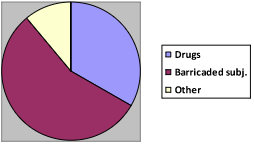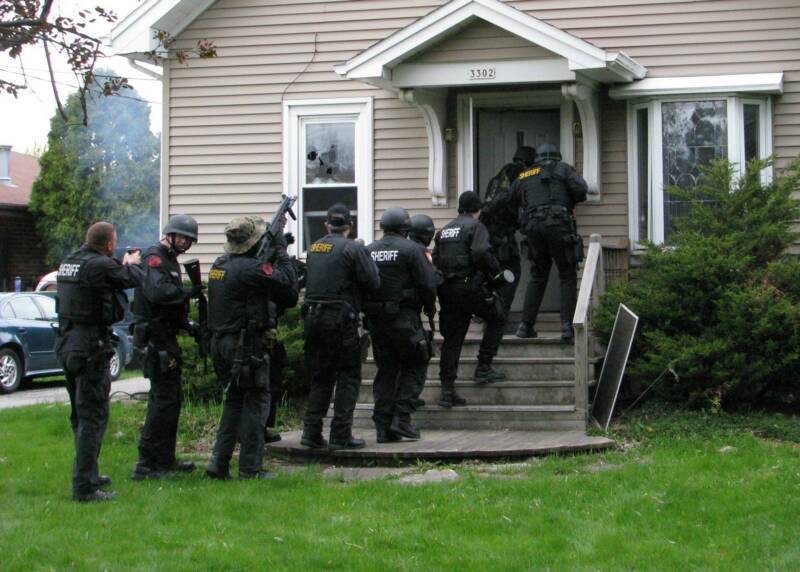Since Ferguson, and more recently Baltimore, the searing images of police wearing riot gear, carrying high-powered rifles, and riding in armored trucks, have made police militarization a national issue. Not only is this a trend in big cities, but also in small towns like Champaign-Urbana where police have recently acquired a Mine-Resistant Armor-Protected (MRAP) vehicle fresh from the wars in the Middle East.
According to Sheriff Dan Walsh, the MRAP will replace an outdated armored truck that is used to transport members of the SWAT team. It will also be useful, he has said, for active shooters, or to rescue stranded motorists during snowstorms. I acquired the police reports for every time the SWAT was assembled in 2014 through a public records request. Reading through some 250 pages, I asked the question: Would an MRAP have been helpful in any of these situations?
Armed and Dangerous
The Sheriff’s SWAT team is made up of police from Urbana, Rantoul, Mahomet, University of Illinois, Parkland College, and Champaign County. (The City of Champaign maintains its own SWAT team but, as we will see, they often receive assistance from outside.) They train frequently, holding exercises at abandoned county facilities, a local mall, or, a few years back, in downtown Urbana. In 2014, they held 13 trainings, just more than one each month. These are funded by federal and state money that is coordinated through the Illinois Law Enforcement Alarm System (ILEAS), established in 2002 shortly after 9-11, and located in east Urbana.
There were a total of nine incidents in 2014 for which the Sheriff’s SWAT team was called out. Typically, they were for two types of situations: barricaded subjects and drug warrants. When it was reported that a person may have access to a gun, the SWAT team was often assembled. In none of these cases did subjects actually display a firearm to police. In two of them, individuals resisted arrest and had to be physically restrained.

Five out of nine incidents were for barricaded subjects. Three were for drug raids. One case did not fall clearly into these two categories. The SWAT team served a warrant for a person who they believed was “armed and dangerous.” He had violated probation while in Drug Court. He fled the scene when police arrived. An MRAP would not have helped police find the man.
Barricaded Subjects
There were a total of five barricaded subjects in 2014. In two out of the four cases, the individuals were suicidal. They both gave up after communicating with a family member.
In one very dangerous situation, an individual was in his apartment claiming he had a .22 pistol (which it turned out he did not have). He had stabbed his girlfriend with a screwdriver and was holding her hostage in the bathroom. In this case, officers were wearing full SWAT gear and carried bullet proof shields into the apartment. The standoff lasted for several hours. The man fought with police until he was put in a squad car. Still, it’s not clear how an MRAP would have been beneficial in this scenario.
The SWAT team was called out to an apartment complex in Rantoul after it was reported that a gun was discharged from a balcony. Police knocked on the door, but residents refused to allow them in. After getting a warrant, police entered the apartment and arrested one man who had to be “forced to the floor” by an officer.
In another incident, the Sheriff’s SWAT team was called out to assist Champaign’s SWAT team. Police responded to a domestic call, and a man who was also wanted on a warrant from the Illinois Department of Corrections refused to come out of the house. After SWAT police ordered the man to surrender, he crawled out a second-story window and climbed down a ladder with no incident. Again, it is not apparent that with an MRAP these situations would have ended differently.
Drug Searches
In three out of nine of these incidents, the SWAT team was used to conduct drug searches after a judge granted a warrant. One of these raids, part of an investigation by the Urbana Street Crimes Unit, was conducted after a drug purchase coordinated by police with the use of a confidential informant, or “snitch,” a person who is often offered to have their own charges dropped if they “cooperate” with police. This early morning raid only turned up a small amount (2.5 grams) of marijuana and cocaine
esidue on a digital scale. One woman on the scene told police their target was not selling crack in large amounts. “For a drug dealer, this is pretty petty,” she said.
The two other calls were to assist Champaign police with drug raids, although there is no indication of the amounts found. The subjects were quickly overwhelmed and detained. The Sheriff’s SWAT team returned for debriefing at the ILEAS building.
There were a total of three times the Sheriff’s SWAT team was called out ― one third of all incidents ― to assist the Champaign Police Department. We should not make the mistake of seeing these two SWAT teams as separate entities. The Sheriff often provides support and will certainly bring the MRAP into Champaign.
Racial Disparity
While names were redacted in many of the reports, race was indicated in all of them. In 2014, seven out of nine incidents involved African Americans, all of them men. All of those targeted for drugs were black. The MRAP will undoubtedly be used disproportionately against African American residents, who are viewed by police as more violent, and the ones more likely to be drug dealers.
Militarization
Throughout the reports, there are other signs of the blurred lines between SWAT raids and military operations. Police will often evacuate buildings and talk of establishing a “perimeter” around a suspect. A team of snipers may take positions. AR-15 rifles are openly displayed by police who are clad from head-to-toe in body armor.
In one instance, members of the Sheriff’s SWAT team used an LRAD (Long Range Acoustic Device), to order a man out of a house. These LRAD devices were developed for the military and are increasingly being seen in civilian use. They can be used as a loudspeaker, or they can emit a high pitched sound for what is called non-lethal crowd control. LRADs were used by police against non-violent demonstrators at the 2004 Republican National Convention in New York, the 2009 G20 Summit in Pittsburgh, and during the August 2014 protests in Ferguson. This is but one more example of police militarization.
There are rare instances in which SWAT teams may be necessary such as hostage situations. But it is questionable whether they are the best way to fight the drug war, or deal with suicidal individuals.
Of course, we all want police to return home safely at the end of the day. Yet in none of the above situations is it apparent that an MRAP would have brought a different resolution.
For further background you can read my 2007 study of several dozen local SWAT raids.








